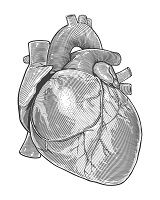Article
Are Hospitals a Bad Place to Have a Heart Attack?
Author(s):
Could hospitals be a bad place to have heart attacks? That's the finding of a North Carolina research team that looked at data from 303 California hospitals. Patients who had heart attacks while hospitalized for a non-cardiac ailment had a more than 3-fold greater in-hospital mortality than patients taken to a hospital.

uld hospitals be a bad place to have heart attacks? That’s the finding of a North Carolina research team that looked at data from 303 California hospitals. Patients who had the attacks while hospitalized for a non-cardiac ailment had a more than 3-fold greater in-hospital mortality than patients taken to a hospital.
Co
Many of the inpatient heart attacks happened to patients who already had life-threatening illnesses.
Some cases of inpatient heart attack deaths may have been unavoidable, the patients other illnesses may have meant they were not candidates for invasive heart procedures.
But the authors suggest that had their doctors been more aggressive in offering treatments like cardiac catheterization percutaneous coronary intervention, some patients might have not have died. These physicians may be giving up on their patients too quickly.
Reporting in
Prashant Kaul, MD of the University of North Carolina at Chapel Hill’s division of cardiology and colleagues found that 62,021 ST-elevation myocardial infarctions (STEMI) occurred in patients in the hospital for non-acute coronary syndrome care.
They were older (71.5 years on average) than a group that had STEMI outside of the hospital (64.9 years on average) and more likely to be female (47.4 % of the inpatients vs. 32% of those who had outside attacks.
Part of the disparity was likely due to the fact that the hospitalized patients tended to be older and sicker than patients who had heart attacks outside the hospital.
But that did explain all the cases where hospitalized patients had heart attacks but saw slow door-to-balloon times, or never got interventions, he found.
“Significant differences in outcomes remained after adjustment for age, sex and comorbidities,” he said.
Those cases included patients who might have been helped by fast and more invasive care, he concluded.
“While the inpatient-onset STEMI population has a higher percentage of patients compared with those with outpatient-onset STEMI, who are not candidates for primary PCI because of excessive risk of bleeding, acute neurological symptoms, family or patient wishes, and severe comorbidities, there are few data to guide these decisions."
Could hospitals be a bad place to have heart attacks? That’s the finding of a North Carolina research team that looked at data from 303 California hospitals. Patients who had the attacks while hospitalized for a non-cardiac ailment had a more than 3-fold greater in-hospital mortality than patients taken to a hospital.
Many of the inpatient heart attacks happened to patients who already had life-threatening illnesses. Some cases of inpatient heart attack deaths may have been unavoidable, the patients other illnesses may have meant they were not candidates for invasive heart procedures. But the authors suggest that had their doctors been more aggressive in offering treatments like cardiac catheterization percutaneous coronary intervention, some patients might have not have died. These physicians may be giving up on their patients too quickly.





